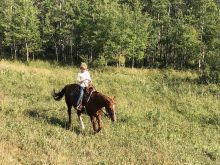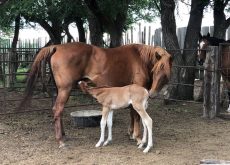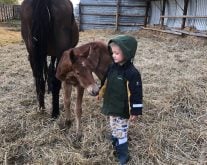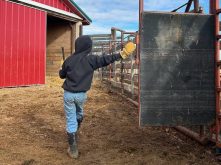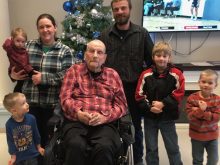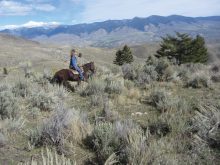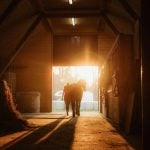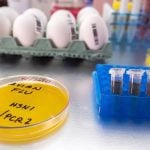February 21
This past week has been bitterly cold. On Valentine’s Day we had a snowstorm and nasty wind. We decided to move the big bulls to the main corral sooner than planned since they refused to drink the water coming through their pen. It’s murky and probably bad-tasting after the waterway was rechannelled through the swamp above it. Eventually it will run better and cleaner. It will take a while for the water to clear up. We’ll be rebuilding one side of the bull corral in a few weeks and were planning to move the bulls during that project, but their refusal to drink made it urgent to move them now.
Andrea and I locked the young bulls out of the main corral. They can have their little pen where I feed them and the lane to the squeeze chute runway and the creek behind it, and the older bulls can live in the main corral. We tied an old feeder panel in the lower corner of the main corral next to the new loading chute and I can throw their hay over the fence into the new feeder.
Read Also

Harvest wraps up and fall work begins
At the Eppich famly ranch in western Saskatchewan, the fall harvest was successful with few breakdowns, cows and calves have been sorted and a new tractor has arrived
Andrea broke ice on the creek to make a water hole for the big bulls, but the bank is steep with thick ice and they were afraid to step down that far. They were still licking snow. So she carried several buckets of water from the creek to put in tubs, and they were grateful. She also put a bale of coarse slough grass in the protected corner by the running chute (which makes a windbreak on that side) for them to sleep in. It was so stormy and windy that Michael and crew didn’t work that day on the fence projects.
The next morning was minus 22 Celsius, but there wasn’t any wind or blizzard, and it warmed up a little by afternoon. The guys braved the weather and put in a full day on the brush-clearing and fence projects. Michael used his mini excavator to drag more brush to the burn piles, and to break ice so bulls and cows could drink. Andrea brought a batch of fresh muffins down for the crew for their lunch break.
Thursday was still cold, but the guys got all the old rotten fence torn out along the lane to the main road. Lynn was able to get the tractor started (though it was grumpy in the cold weather in spite of being plugged in all night) and we were able to load another big bale on the feed truck.
Michael and crew got all the new posts set along the driveway on Friday, and had to pound through more than a foot of frost. Andrea and I put two poles along the bull feeder to keep them from bending and breaking the old metal. Now they have to push against the poles instead of just the feeder. They were starting to bend the old metal.
Sunday evening we had Nick here for supper and another good visit. We showed him the book Emily had printed for me — the first 10 years of the blog I started after my book “Beyond the Flames — A Family Touched by Fire” was published. Nick enjoyed looking at all those old photos. Lots of family history there.
Yesterday was the warmest day we’d had for a long time — above freezing by afternoon. The blackbirds came back and were singing in the cattails.

Andrea had Christopher that day and he went with us to feed cows. He played with his little trucks and tractors on the flatbed after we fed the hay, while I walked through the cows to see how soon some might start calving.
Today was windy. It snowed five inches here, and 12 inches the upper place where Michael and Carolyn’s cows are. They have more than two feet of snow now.
March 1
A week ago it was very cold, with a terrible wind. Andrea’s four-wheeler wouldn’t start so she hiked down to help me feed cows and break ice on the creek for the bulls and cows. We had an oil pan heater on the feed truck (since the engine heater no longer works) and it started, so we put it on the tractor (to help warm it, along with the engine heater that was plugged in all night, and a canvas around the engine to block the wind).
We fed the cows close to the brush and put five little bales in the brush for bedding. Andrea gave the bulls more bedding and tied an irrigation dam on the upper fence in the creek water hole to block the wind. The little bulls have been sleeping in there because the brush is thick on three sides and it’s a good shelter.
By midafternoon Lynn was able to start the tractor. It was sluggish, but with the extra help from the oil pan heater it did start — so we were able to load a big bale on the feed truck. While he had the tractor running he plowed through the big snowdrift along Andrea’s driveway, and the deep snow on the main road by our mailboxes.
The guys took several days off from fencing; weather was too miserable to work. We took more bedding bales up to the brush for the cows. Friday was a little better so Michael and Carolyn braved the bad roads and made a trip over the mountain to Lima, Montana for more poles. The road had been closed for several days because of drifting snow. Nick and Matt finished putting wire on the new fence along the lane, and hung gates in the new little pastures below the bull corral.
Saturday Andrea helped me repair the little bulls’ feeder; they are not so little anymore and broke one of the uprights; they broke the weld at the top, but the bottom was still hanging on. We straightened it up and drove a steel post inside the feeder to reinforce it and tied the upright bar to the steel post.
Yesterday was cold again, but Michael started tearing down the old chicken house behind the shop next to the calving barn. It’s been falling down with the roof caving in, and needs to be removed so we can utilize that space for more grazing. A few of the old things stored in there — some are antiques — were salvaged, and the rest they hauled down to the post pile pasture to crush and bury or burn.
Today we had more snow but the guys kept working on the demolition project. They got more of the chicken house gone, and the old outhouse. Next was the tack-room building across the driveway — where we used to keep our saddles and other horse stuff until we made a place for them in the back porch where the mice couldn’t get at them.
The little building had a lot of stuff stored in it for the past 50-some years, but the roof was coming off, and it was no longer a viable structure. Nick took everything out of it — old tires, a pile of asphalt shingles, and many things that are no longer any good — plus a few antique treasures. He sorted what to keep and what to send to the trash pile, while Andrea, Lynn and I went to the annual water meeting for our water district. It was determined that the district needs to find a new water master. The one we’ve had the past two years (Tony) doesn’t want to do it again.
March 14
Last week the guys got the old tack building removed, and burned brush for several days in the little pen we’ll now have alongside the calving barn. They took out all the brush that’s overgrown that area and cleared it out.
They sawed out the huge sagebrush that grew next to the little Ford tractor (1960 model) that was parked by the tack room building for nearly 35 years. Then they were able to move the tractor and took it to the hold pen where it now sits alongside the old red International Harvester model H (1950) which was the first tractor Lynn ever drove; his dad let him drive it in the driveway the day he brought it home from the dealer, when Lynn was seven years old.

Michael and crew got all the old junk and machinery out from behind the old blacksmith shop and tore out the old fence. To get to it, they had to unhook the power line that went from the shop to the calving barn. The old pole that originally held it up started to fall down years ago and we’d hooked the power line to the old shop roof — so it was too low to work under with the mini-excavator. The power had to be “off” in the barn until that cleaned up, the fence rebuilt, and a new pole installed.
The heifers’ water tank heater depends on an extension cord from the barn, so it wasn’t working for the six days that the power to the barn was off. I was breaking ice on their water every morning and scooping it out with a shovel.
Monday, after Lynn and Andrea loaded the feed truck they took the tractor up through the fields to heifer hill (through about two feet of crusted snow — almost more than the tractor could get through, even with chains on). They dug an old 40-foot pole out of the snow. It was a full-treated pole that was extra when we replaced the bridge timbers (that were rotting out) in the bridge across the creek for Andrea’s upper driveway. Though it’s been lying at the edge of the field for 12 years, it is still sound and solid and will work as a new power pole. Andrea hooked a chain on it and they dragged it down through the field on the snow.
The next day I put Dottie in the side pen, and Ed in Breezy’s old pen so the guys could tear out their old fence. The fence for Dottie’s pen had been hit several times with the stack wagon and other equipment because the lane by my hay shed was always too narrow. Some of the old poles were rotten, and the horses were chewing on them. The guys will rebuild that fence, moving it a few feet to make the lane wider, and use net wire on it instead of poles (with a hot wire to keep the horses out of the fence).
Andrea screwed some boards along the bottom of the stall walls in the calving barn, on the side toward the creek where the cats and skunks have been going in and out. We need to close up those holes to keep critters out of the barn when we have cows and babies in there, and keep the wind from blowing in.
Thursday Michael and Carolyn drove to Montana again to get another load of poles, before a storm arrived on Friday that would make the roads impassable. Nick and Matt starting rebuilding the horses’ fence — but the ground was too solidly frozen to set posts. They set several “ovens” to thaw the ground. These ovens are half barrels with holes cut out for a smoke vent, and screen over the top to keep sparks from flying out and catching anything on fire. Fires in those ovens can thaw the ground underneath.
Friday morning it was snowing lightly when the guys came to work but they wanted to make progress on that fence. The ground was still difficult to drive posts, with the rocks and frost; they spent all day setting most of the posts (which ordinarily would have taken a couple of hours). Some were impossible to drive without digging out some of the rocks. Nick spent nearly two hours on one post hole that was solid gravel and ice. Oh, the joys of building fences in wintertime!
To make it even more challenging, we had some gusts of wind, up to 40 miles per hour. But they persevered and got all but four of the posts set, not even stopping for lunch.
Andrea had Christopher for the weekend. He rode with Lynn in the tractor to break down deep snow in the orchard and horse pasture. Then we were able to drive in his tracks with the feed truck and spread hay, in preparation for bringing the cows down.
Sunday was a nice day for moving the cows. I tied hay twines together and made long strings of fake hot wire to put along the lane by the bulls so the cows would stay out of the bull hay and the machinery. Lynn took care of Christopher at Andrea’s house and Andrea and I moved the cows, leading them down from the field with the feed truck, through the corrals and barnyard to the orchard (maternity pen) and horse pasture. The snow is still very deep and dense out there but the cows can tromp it down and hopefully we’ll get some warmer weather before the first calves arrive.



